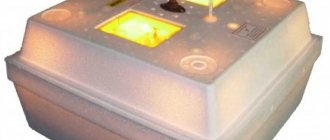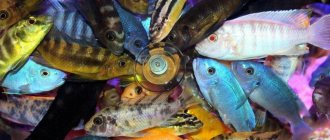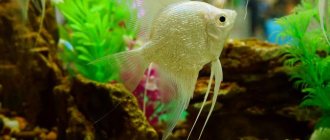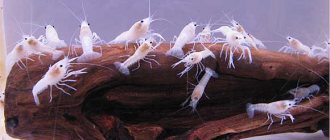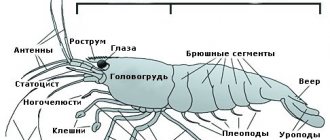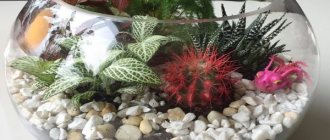From the outside it may seem that caring for a home aquarium and even breeding your favorite fish is a simple matter and does not require significant effort. However, to make a small home pond look well-groomed and its inhabitants feel good, effort will be required.
If you carefully monitor the water parameters and temperature in the aquarium, choose good food and do not forget to change the water, you can speed up the spawning of fish. And not only unpretentious guppies, with good care even such capricious fish as angelfish will lay eggs.
Angel fish
The hobby of many aquarists began with their acquaintance with this leisurely fish with long lacy fins. In nature, angelfish (Pterophyllum scalare) live in the slow waters of the tributaries of the Amazon, among thickets of plants, in the shade of which they hide from danger and gather to spawn. The body of the fish, very flattened on the sides, is ideally designed to maneuver between the roots and leaves of plants.
The name of the angelfish (Zeus scalaris) was given to this species of then still wild fish in 1823. However, in Germany, breeders still call the fish Segelflosser, which translates as “sail”. And in the United States they are known as “angelfishes” (Angelfishes or simply Angel).
Over several decades of aquarium breeding, these fish have been able to adapt to almost any conditions. They can feel normal in both soft and hard water, and small temperature fluctuations are not scary for fish. However, if you want the angelfish to lay eggs, they will need to create conditions suitable for this.
General information about the business, pros and cons
It is quite possible to breed sturgeon at home; the main thing is to provide all the necessary conditions for this. The sturgeon family includes not only the Siberian and Russian sturgeon itself, but also sterlet, stellate sturgeon and beluga.
The described types of fish have tasty and healthy meat and caviar. Breeding them is not difficult, and the demand for this fish is always high.
The advantages of business in the cultivation and sale of sturgeon fish include the following:
- high demand for carcasses and caviar;
- sturgeon’s unpretentiousness to breeding conditions: this fish easily adapts to temperature changes and is not too picky about food;
- quality and environmental friendliness of products;
- rapid growth of fish;
- obtaining not only fish meat, but also caviar, which is highly valued;
- quick return on investment – it takes about 9 months;
- no need to spend a lot of time caring for fish;
- insignificant susceptibility of sturgeon to various diseases.
The disadvantages of this type of entrepreneurial activity include the long period of time for fish to reach sexual maturity, as well as the frequency of reproduction, which is more than one year.
If an entrepreneur plans to breed sturgeon for caviar, he should take into account that this is a long and labor-intensive process. If a fish farming business pays off in 9 months, then growing sturgeon for black caviar will pay off only after a few years.
Life of schooling fish
Some types of aquarium fish, for example, almost all bottom-dwelling catfish, feel great alone. With angelfish, everything is not so simple; in nature, they are schooling fish, living in groups of 10–15 individuals. And even long-term domestication could not change this habit: representatives of this species feel good only in a group.
Experienced aquarists advise choosing a dozen small angelfish with wide and long fins. Then, as they grow older, the fish themselves will split into pairs. Usually in an aquarium there is one dominant pair of angelfish, the largest and with a good appetite. The rest of the fish will stay away.
Most likely, it is this dominant pair that will lay angelfish eggs in the aquarium. Although, if the aquarium is large enough and has a lot of plants for cover, other fish will also have a chance to reproduce.
How do aquarium fish lay eggs?
Here are the spawning carp teeth, or cypridontids.
Their ancestors live primarily in tropical regions of Africa. But in aquariums they live everywhere and are among the most common. Varieties of zebrafish are very popular, and above all zebrafish, commonly known as “danya”, “lady’s stocking” - a nimble fish 4 centimeters long. Longitudinal black and blue stripes run along its body, including the tail and anal fin. There are small antennae at the corners of the mouth. He prefers live food - daphnia, bloodworms, but lives and reproduces well on fortified dry food. The female is plumper than the male; her abdomen sag noticeably. A great advantage of zebrafish is its insensitivity to temperature changes. They feel equally good at 26 and 12 degrees. Therefore, they are also suitable for poorly heated reservoirs. The best living conditions for three zebrafish (nests, as aquarists say): water level 30 centimeters, temperature 22 degrees, sandy bottom, any plants, but you must leave a place where the fish can frolic.
Characinids are also popular among aquarists. The most common species found in indoor ponds are thornets, tetragonopterus and tetra von rio. Each of these fish is good in its own way. Ternetia has a peculiar black skirt, Tetragonopterus sparkles very beautifully in the evenings in side lighting, Tetra von Rio is bright and mobile.
Tetragonopterus is the largest of this family. He is of Mexican origin; The body shape is similar to a roach. Its four fins - caudal, ventral and anal - are bright red, the rest are transparent. There is a greenish stripe in the middle of the body, ending at the tail with a black diamond. A very beautiful and lively fish that gets along well with other inhabitants of the aquarium. It is very easy to distinguish males and females: females are large and massive, males are thin and small.
This fish is very unpretentious, only during spawning it is necessary to heat the aquarium so that the temperature in it rises to 22 degrees. She needs a large aquarium, and part of it should be densely planted with plants.
Tetragonopterus is a rather spoiled creature: it won’t even pick up a living bloodworm from the ground. Therefore, a floating moth is necessary. In a well-organized aquarium, it does not require additional oxygen flow.
Pair for angelfish
Experienced aquarists do not recommend separating an already established pair of fish, even if the breeder does not entirely like this “union”. For fish this is extreme stress, possible refusal of food, and even the death of the pet.
If you really want to breed juveniles with certain characteristics, you can try placing a male and a female of the appropriate gender and size in a separate aquarium. It is quite difficult to determine the sex of young fish; there are several common signs:
- Males have a more elongated, long dorsal fin.
- The number of transverse contrasting stripes on the dorsal fin in the female is no more than 6, and in the male more than 7.
- Males are usually larger and have a round body. Females have a smaller body and are not so rounded, rather angular.
- The male has a more convex round forehead, which will become golden in color with age. In females, the forehead is sloping and visually merges into the dorsal fin.
Business plan
Before you start implementing a business idea, you need to develop a detailed plan that will take into account all expenses and income, as well as determine the profitability of the business and the payback period.
If we assume that a ton of sturgeon will be grown within 9 months, then the cost items will look like this:
- tank for fish breeding: the cost depends on the size and manufacturer, the price can range from 100,000-500,000 rubles;
- pump – 9,000 rubles;
- purchase of sturgeon fry in the amount of about 1,800 pieces - about 30,000 rubles;
- biofilters – 10,000 rubles;
- oxygen generator – about 20,000 rubles;
- purchase of fish feed (1,500 kg) – 70,000 rubles;
- payment for electricity (up to 30,000 rubles per year);
- various small expenses (50,000 rubles);
- payment of wages to employees, the level of costs depends on their number.
With the proper approach and organization, a return on business can be expected within the first year from the start. The cycle of growing fry, ending with the receipt of marketable products, takes about 9 months. Net profit after the specified period will be about 250,000-300,000 rubles.
Starting from the second year of sturgeon cultivation, every thousand fry purchased and released into the reservoir will bring up to 200,000 rubles in net profit.
Conditions for reproduction
In order for the selected pair to successfully lay eggs, they need to create optimal conditions. Despite the assurances of manufacturers, it is better to feed the fish with live food (bloodworms, cyclops, daphnia) before spawning, then the pets will have a brighter color and a desire to reproduce.
The spawning aquarium must be planted with living plants with large, dense leaves. Most likely, the angelfish will lay their eggs in the aquarium on one of these sheets. It’s good if duckweed or other small plants float on the surface of the water, they will provide comfortable twilight and additional vitamins for green-eating producers.
Without relying on plant leaves, you can lower a piece of dark plastic or a smooth ceramic pot into the aquarium. Of course, they should be thoroughly washed first. Perhaps a pair will choose these surfaces for spawning and eggs will soon appear on them. Although parents' preferences are unpredictable, and you can see angelfish caviar on the filter, and not on carefully prepared items.
“Salmon” is the collective name for a family of fish
Salmon caviar is produced from chum salmon, pink salmon, coho salmon, and sockeye salmon by treatment with a solution of table salt, sometimes with the addition of antiseptics.
Coho salmon The eggs of this fish are smaller than those of pink salmon (about 4 mm), dark red in color with a predominance of burgundy. Coho salmon caviar has a characteristic bitter taste. It ranks first in nutritional properties.
Pink salmon caviar can be called a “classic” among other types of salmon caviar. It has a neutral taste, medium diameter (about 5 mm) and bright orange color. The shell of the eggs is not strong enough, so when the caviar is stirred, some eggs burst, forming juice, that is, caviar juice. Pink salmon is one of the most prolific fish in its family, therefore it is most often used by caviar producers. In terms of its nutritional properties, it ranks second and is second only to coho salmon caviar.
Tsar's caviar is chum salmon caviar. The size of the eggs in diameter is 5–6 mm. Large eggs have a regular spherical shape, a bright amber-orange color and a clearly visible fatty spot-embryo. Due to its effectiveness, chum salmon is often used to decorate dishes. However, not everyone likes the taste of chum salmon caviar - it has a rather dense shell.
Red salmon. Sockeye salmon caviar is bright red in color, smaller than pink salmon (average diameter - 4 mm). This caviar is extremely rare in Russian stores, because this type of fish is not common in the country. The largest populations of sockeye salmon are found along the American coast (from Alaska to California). It should be noted that sockeye salmon is one of the first salmon fish species to spawn, so it reaches the market earlier than others. Sockeye salmon caviar is often smuggled into Russia, since the import of this caviar into our country is prohibited.
Trout. Trout caviar is the smallest of all the species presented (the average diameter of the eggs does not exceed 2–3 mm). The taste has a slight bitterness and a fishy aftertaste. The color of caviar is either yellow (dark yellow) or red (bright red). Trout caviar is usually served on canapés and sandwiches, as its eggs are sticky and quite salty.
Temperature and water changes
To stimulate, the water temperature should be increased to 28° C; in fish, at the genetic level, this will be an indicator of the beginning of the warm season and the time of spawning. In nature, it is with the onset of warmth that young individuals begin to break into pairs and lay eggs.
You will also need to regularly do water changes 3-4 times a week, replacing approximately 10% of the total volume. It is important that distilled or pre-boiled water must be added to reduce its hardness. And the temperature should be close to the one in which the pets are used to living.
Options for arranging reservoirs for sturgeon
To provide the conditions necessary for the life and reproduction of fish, it is necessary to equip the reservoir properly.
At the initial stage, one container is enough - a plastic pool, which is quite easy to maintain. If the starting scale of production is not too large, then the depth of such a tank can be 1 m, and the diameter can be from 1.5 to 2.5 m.
A pool with sturgeon should be located in premises with an area of 30 sq. m. m. They must have a heating system so that the fish do not freeze during the cold season. In addition, the premises must have electricity, sewerage, water supply and ventilation.
To ensure active growth of sturgeon, the water temperature in winter should be at least 17 degrees.
The room with sturgeon, which are not resistant to stress and external irritants, should be located in quiet places. There should not be crowded places, railway tracks or highways nearby. You can place a pool with sturgeon in a garage, a permanent shed, or a polycarbonate greenhouse.
The arrangement of such an artificial reservoir is discussed in this video:
If there is a pond at your summer cottage, then you can organize the breeding process of sturgeon in it. First, you should thoroughly clean its bottom and ensure an influx of fresh water, as well as enrich it with flora. You can also dig a pond yourself.
A natural pond should grow algae and various aquatic plants. It is advisable to throw snails, plankton, and worms into it.
Angelfish caviar in an aquarium
Fish of this species should not be removed from the general aquarium before spawning. Of course, unless they have large neighbors with a good appetite.
Signs that the pair is preparing to spawn will become noticeable within a few days. They will begin to jealously guard part of the aquarium, driving away all neighbors from there. Usually the male does this, and the female carefully cleans the selected surface.
An inexperienced aquarist can easily miss these signs and only accidentally notice that angelfish have laid eggs in a community aquarium. Having discovered this, you need to observe how the parents behave and how serious the gastronomic interest in caviar is shown by the neighbors.
Spawning
The reason is still not clear, but angelfish prefer to spawn in the evening, closer to night. The female lays a series of eggs on a selected and thoroughly cleaned leaf or object. It swims away a little, giving way to the male, who fertilizes the eggs. Then they change places again, and so on several times. These coordinated movements resemble an underwater dance.
Spawning can last from forty minutes to one and a half hours, during which time the female will lay more than 500 eggs. In an adult large individual, the number of eggs can exceed a thousand. And the male will be nearby all the time.
Angelfish eggs look like small transparent grains that thickly cover a leaf or glass of an aquarium. In fact, the yolk sac of this tiny ball contains enough nutrients for the birth of a full-fledged small fish.
Angelfish have laid eggs: what to do?
The first two days after spawning, parents protect the future offspring, driving away uninvited guests from them. They improve water circulation by fanning the eggs with their dorsal and pectoral fins, and carefully clean the rows of balls, pecking off the whitened dead samples. By this, the fish prevent damage to neighboring eggs.
After a couple of days, the larvae begin to hatch. It looks like this: thin movable tails appear from the angelfish eggs, resembling transparent threads.
During this period, a pair of parents carefully transfers the moving eggs with their mouths to a neighboring leaf. Thanks to their innate instinct, they protect their offspring from death, because proximity to deteriorating empty shells is very harmful.
The development of the larvae continues for another 7–12 days, during which time the supply of nutrients in the yolk sac runs out and, finally, fry from the angelfish eggs appear.
A pair of parents protect and care for their offspring until the small fish begin to feed on their own.
In fact
Although parental care is extremely important for the development of small fish, adult fish do not provide as much care. Even if you place the selected pair in a separate aquarium, there will be no guarantee that the parents will care for the eggs. This is especially true for young individuals.
And angelfish (fry) simply have no chance of hatching from eggs in a community aquarium without outside help. At best, the couple will try to protect the eggs for the first two days. But the stress from spawning and the interference of voracious neighbors leads to the fact that some of the offspring will be eaten and the rest will disappear.
It happens that when darkness falls, the parents themselves get lost and eat the recently laid eggs.
There are several options for what to do with angelfish eggs in a community aquarium. You can leave everything as is, then the pets will receive an additional portion of food, and the pair will be ready for the next spawning in about a month.
And those who set out to raise a school of small fish have two options: place the parents together with the eggs, or equip a small aquarium and turn into a nanny for a while.
Conditions for landing and growth of fry
Raising fry at the initial stage of business at home is quite problematic. It is much easier to buy them at fish farms that specialize in sturgeon breeding. Buy fry weighing at least 5 g and launch them into a pond in warm weather. The most suitable time is late spring or summer.
Fry can be raised from eggs, but it is much easier to buy them
Sturgeon can live at a temperature of +2°C..+ 27°C. But for active growth, fish require indicators of +18°С…+22°С. Such conditions ensure early maturation of sturgeon.
Females begin to spawn at the age of 6 years, whereas in the wild this occurs only at 12–15 years of the sturgeon’s life.
Important! There should be no more than 60 kg of fish per 1 square meter of reservoir.
Caviar with parents
You can place the pair along with the eggs in a separate aquarium, then the fry will have a greater chance of hatching. Parental care is very important for the health of small fish, but difficulties may arise during transplantation:
- Additional aquarium. Few aquarists, especially beginners, can boast of having another tank with a volume of 50–80 liters. And in a smaller volume of water, two large fish will not feel comfortable and care for their offspring.
- The water parameters in a new aquarium should correspond as closely as possible to the water in general. It is optimal to take 30–40 percent of the water from the general aquarium, and add the rest of the volume with distilled or boiled water.
- Adult fish may react poorly to being moved to a new location and may stop caring for the eggs.
Equipment
To breed sturgeon on a home farm you will need:
1. Automatic feed dispensers and feeders.
You can give food to fish manually, but these devices greatly facilitate the procedure and save a significant amount of time.
2. Pumps for pumping water.
During the selection process, look for models that can operate efficiently without being at the power limit. Otherwise, the pumps will not last long.
3. Oxygen generators (aerators) to provide fish with oxygen. 4. Pipes for creating a closed water supply circuit. 5. Sterilizers and filters for purifying the reservoir from contaminants, food residues and fish waste products. 6. Incubators for hatching larvae (if you do not buy fry). 7. Libra. 8. Containers for sturgeon. 9. Freezers. 10. Nets, buckets.
Separate aquarium for fry
A good option would be to prepare a small aquarium for the fry, into which you need to transfer the eggs. It should be transported carefully, together with the object to which the eggs are attached. If the grains are on the leaf of the plant, you will have to sacrifice the leaf and carefully separate it from the stem.
In order for the fry to appear successfully, the aquarium for them must meet certain requirements:
- It can be small, 10 or 20 liters, but it must be cleanly washed and disinfected using Aquacons antiseptic conditioner. It’s a good idea to add a few drops of this drug to the water for fry.
- Take half the water from the general aquarium, add the rest with boiled or distilled water.
- There should be no soil or decorations in the aquarium, but it is necessary that the lighting lamp is constantly on.
- Be sure to place a heater and an air diffuser there. Wait about an hour and transfer the item with the caviar. It must be positioned so that the eggs are washed by the flow of water from the aerator, but the air bubbles do not touch them. This will create the same effect as fanning the eggs with the parents' fins.
- Place small plants such as duckweed on the surface; they will grow quickly in the light and create shelter, and then food, for small fish. In addition, having live plants will prevent nitrate levels from rising when the fry begin to actively grow.
Several times a day, you need to remove frozen eggs with tweezers, trying not to damage the neighboring grains. If all goes well, after two weeks the first small fish will begin to appear.
Production stages
Extraction of red caviar
- an extremely complex process that has its own main stages, each of which we will discuss further.
Stage No. 1 – catching fish.
The process is carried out using trawls, fixed seines, nets and other possible gear that are available on specially equipped vessels. Red caviar in Kamchatka and Sakhalin is mined from June to October. To catch, vessels do not need to sail far from the shore, since the fish accumulate near the coast in order to rush into the rivers to spawn. Fish are delivered from fixed seines to receiving and processing vessels.
Stage No. 2 – cutting.
After catching, the fish enters the cutting line, where it is gutted, separating the caviar, entrails and carcass. The internal organs are dumped into the ocean and the fish are taken to the lower deck for further processing. It is washed, sorted, frozen, packaged and sent to the freezer hold. At the same time, other workers sort the eggs by type. Next, the caviar is washed with sea water.
Cutting takes place directly on the water, since the longer the caviar was inside the carcass after the death of the fish, the worse its quality. Therefore, the extraction process must be immediate on the ships themselves or on the accompanying water factories.
Stage No. 3 – caviar processing.
After being extracted from various breeds of salmon fish, red caviar is located in oysters - a film that prevents the eggs from moving inside the fish. Liberation from yastyki occurs as follows:
- caviar is passed through butara machines twice - purification occurs due to vibration and rubbing through a sieve;
— after the butara, the product goes down an inclined gauze, which also retains film particles, blood and other residual contaminants.
Stage No. 4 – salting
. After screening - cleaning from the eggs, the eggs are placed in vats with a saturated saline solution, the so-called brine. The caviar-brine ratio is 1/3. Caviar should be saturated with salt by 4%. This takes from 10 to 20 minutes, depending on how heavily salted the brine is.
Stage No. 5 – drying
. After salting, the caviar is packaged in small baskets, which in turn are placed in a centrifuge for 10-15 minutes. This removes excess moisture from the product.
Stage No. 6 – final cleaning control, adding preservatives.
Without the latter, long-term storage of the product is impossible. It is legal to use preservatives for caviar: E200 and E211.
Caring for fry
Raising young animals is much more difficult than caring for adults. For the first food, small ciliates or daphnia are suitable. Around the fifth day, you can give small Artemia crustaceans; you can hatch them yourself or buy them at a pet store. You should not feed your fish egg yolk, it quickly deteriorates and becomes covered with fungus, which affects the water parameters.
The fry need to be given food five times a day, at regular intervals. It is very important to carefully remove food debris from the bottom using a small siphon.
On the fifth day, you can install a small filter, this will help regulate the purity of the water. Just to prevent the fry from being sucked into it, first wrap the filter with a thin cloth or nylon stocking.
After about a month, the fish will acquire the shape characteristic of angelfish and will gradually begin to eat crushed food for adults.
After a few more weeks, you can place the grown young fish in a community aquarium or start looking for a new home for the fish. In many pet stores you can exchange healthy young fish for food or necessary equipment.
Types of starter feeds for fry of spawning fish
Under artificial conditions, aquarists have identified several types of live food that meet certain requirements, such as ease of cultivation/breeding, the amount of food received in relation to volumes, the more the better, and the speed of reproduction. Such starter live foods include ciliates and rotifers. Rotifers are divided into saltwater and freshwater. The most common natural food for fry in the first stages of development is “live dust”, which includes ciliates, rotifers, nauplii (larvae) of small crustaceans. Organisms included in living dust are bred, both together and separately. From my own experience, I will say right away that joint breeding is almost impossible; sooner or later one crop will displace another due to different rates of reproduction. The aquarist himself decides what kind of food to breed, based on the preferences of the fry and its size, since the fry of certain types of fish are so small that some types of microorganisms are not suitable for them. Or vice versa, the fry is large enough and can immediately eat Artemia nauplii. Ciliates or rotifers are bred separately from the fry, in so-called cultivators, from which, if necessary, part of the culture is removed and fed to the fry. It is impossible to add live dust along with the medium in which it was cultivated to the fry; the food is decanted, cleaned, and then introduced into the hatchery.
The second type of food is dry industrial food, which can be used to feed fry from a young age. With the development of aquarists, more and more food of this kind appears on the market, which have dimensions comparable to ciliates, that is, in the form of dust. Such food is quite nutritious and can be used to feed the fry, but not all fry will take it, this is due to the fact that the fry does not perceive stationary food as food at all, at least in the first stages of growth. Some fry can be accustomed to them, and when an aquarist appears at the baby fish, the lid of the aquarium is lifted, the light is turned on, the young fish will develop a reflex to eat particles of food falling in the water column.
Raising the fry is closely related to the quality of feed, its composition and nutritional value; if the fish does not receive all the elements sufficiently, the weak ones begin to die. This happens when growing both on live food and on dry food, but if when feeding with live food the waste can reach, for example, 10% of the total number of fry, then with dry food it is 30-50%, it depends on many factors.
